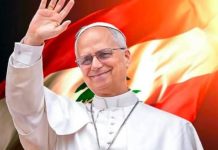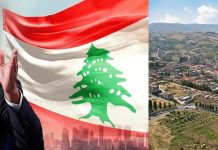In pictures: Hezbollah’s child soldiers
Evidence of Party of God sending minors into battle has mounted steadily over the last year
Alex Rowell/ Now Lebanon/August 18/15
 In July 2014, Hezbollah buried a 16-year-old fighter, Muhammad Ali Hussein Awada, who had been killed fighting Syrian opposition militants in the mountainous Lebanese-Syrian border zone. The revelation of his age, observers noted at the time, implied the Party of God – straining to hold larger swathes of territory with fewer men – had abandoned its former requirement that all fighters sent into live combat be at least 18 years of age.
In July 2014, Hezbollah buried a 16-year-old fighter, Muhammad Ali Hussein Awada, who had been killed fighting Syrian opposition militants in the mountainous Lebanese-Syrian border zone. The revelation of his age, observers noted at the time, implied the Party of God – straining to hold larger swathes of territory with fewer men – had abandoned its former requirement that all fighters sent into live combat be at least 18 years of age.
Since then, evidence of Hezbollah sending children – defined by the UN Convention on the Rights of the Child as all people under 18 – to the frontlines of the war in Syria has mounted steadily. The pro-Hezbollah website SouthLebanon.org, which publicizes funerals of the militia’s fighters killed “in confrontation with the mercenaries of disbelief and Wahhabism” – a reference to Sunni militants – has to date published photos of over two dozen “mujahideen martyrs” who appear likely to have been under 18 (see above image).
When the case of one obviously juvenile fatality, that of 15-year-old Mashhoor Shams al-Din, came to light in April 2015, the Party issued a statement denying he was killed fighting in Syria, claiming instead that he succumbed to a “saddening accident” in south Lebanon. Syrian opposition activists had asserted he was killed fighting in Syria’s Qalamoun region; the same place 16-year-old Awada was killed the previous year.
Lebanon is no stranger to the use of child soldiers. During frequent clashes in the northern city of Tripoli in 2012-13 between the feuding neighborhoods of Bab al-Tabbaneh and Jabal Mohsen, several videos emerged of children participating in the battles, including one of a boy scarcely out of infancy, the recoil of his AK-47 almost knocking him off his feet.
Throughout the 1975-90 civil war, too, child soldier recruitment was widespread, with Progressive Socialist Party militia leader Walid Jumblatt, for example, admitting to using soldiers “as young as ten.”
And in the present Syrian civil war, a June 2015 UN report found almost every faction, pro- and anti-regime, from Hezbollah and the so-called Popular Committees to ISIS and Jabhat al-Nusra to the Kurdish YPG and the Free Syrian Army, to be guilty of deploying child soldiers.
International law forbids the recruitment of soldiers under 18, especially by non-state militias, such as Hezbollah. Article 4 of the Optional Protocol to the Convention on the Rights of the Child on the involvement of children in armed conflict (OPAC), adopted by the UN General Assembly in 2000, says, “Armed groups that are distinct from the armed forces of a State should not, under any circumstances, recruit or use in hostilities persons under the age of 18 years.” It also stipulates that “Parties shall take all feasible measures to prevent such recruitment and use, including the adoption of legal measures necessary to prohibit and criminalize such practices” – meaning Lebanon, which is a signatory to OPAC, is compelled by international law to take action to prevent Hezbollah’s – and any other militia’s – ongoing use of child soldiers.
 In July 2014, Hezbollah buried a 16-year-old fighter, Muhammad Ali Hussein Awada, who had been killed fighting Syrian opposition militants in the mountainous Lebanese-Syrian border zone. The revelation of his age, observers noted at the time, implied the Party of God – straining to hold larger swathes of territory with fewer men – had abandoned its former requirement that all fighters sent into live combat be at least 18 years of age.
In July 2014, Hezbollah buried a 16-year-old fighter, Muhammad Ali Hussein Awada, who had been killed fighting Syrian opposition militants in the mountainous Lebanese-Syrian border zone. The revelation of his age, observers noted at the time, implied the Party of God – straining to hold larger swathes of territory with fewer men – had abandoned its former requirement that all fighters sent into live combat be at least 18 years of age.





















